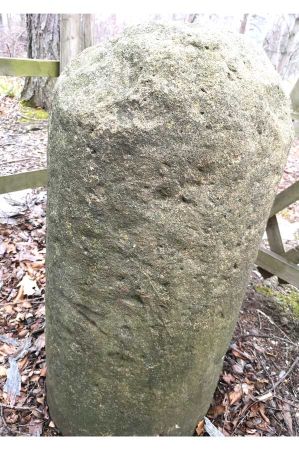Scheiblingstein - a Roman milestone in the Vienna Woods
- Written by Portal Editor
The Wienerwald has also been populated by people since time immemorial. Neolithic residential pits, which were discovered in 1914 when trenches were dug, were found on the Simonsberg in the Weidlingbach municipality as early from the Neo-Gothic era (2200-1800 BC).
On the Kumenberg near St. Andrä-Wördern there was a settlement from the time of Middle Hallstatt Culture. The Veneto-Illyrians - an Indo-European tribe from the Mediterranean region - were strongly influenced in these years around 500-300 BC by the Celts advancing to the east - also an Indo-European tribe from Western Europe.
Few people know that a Roman milestone is located near the Austrian capital Vienna, in the middle of the mysterious Vienna Woods and just a few meters away from the road. Shortly before the eastern entrance to Scheiblingstein, near the Exelberg, it is the approx. 1m long, elongated stone, which has the shape of a Roman milestone, the inscriptions of it is largely illegible and weathered.
A Roman road across the Wienerwald
 Road construction in the actual word meaning took place in the region around Vienna for the first time by the Romans, who were considered masters of road construction in antiquity. They built the Danube Limes from east to west as the great army road of the empire. The section from Carnuntum via Vindobona - Cannabiaca (Klosterneuburg) - Comagenae (Tulln) avoided the Greifensteiner Narrows endangered by the Danube river and instead led through the Kierling Valley - the valley floor itself was avoided - over the saddle from Gugging (Citium) to Comagenae.
Road construction in the actual word meaning took place in the region around Vienna for the first time by the Romans, who were considered masters of road construction in antiquity. They built the Danube Limes from east to west as the great army road of the empire. The section from Carnuntum via Vindobona - Cannabiaca (Klosterneuburg) - Comagenae (Tulln) avoided the Greifensteiner Narrows endangered by the Danube river and instead led through the Kierling Valley - the valley floor itself was avoided - over the saddle from Gugging (Citium) to Comagenae.
The Tullnerfeld had gained particularly military importance in the second century, Tulln itself was an important transition base over the Danube in the third century, a trading center and naval base, so to speak. Part of this important connecting road ran along the mountain edge via St. Andrä to Königstetten, from where a connection led via the Scheiblingstein, the Exelberg and along the Alserbach to Vindobona.
Another milestone at the Hotel Scheiblingstein
 There is another Roman stone three hundred meter southeast of the Hotel Scheiblingstein, about which Julius Caspart reports the following: On May 16, 1935, the Central Office for Monument Protection in the Federal Ministry of Education led by Professor Dr. Georg Kyrle examines the stone. The stone no longer shows any inscriptions or signs. Polaschek's guarantor for the documentary attestation of the Scheiblingstein is Gustav Winter.
There is another Roman stone three hundred meter southeast of the Hotel Scheiblingstein, about which Julius Caspart reports the following: On May 16, 1935, the Central Office for Monument Protection in the Federal Ministry of Education led by Professor Dr. Georg Kyrle examines the stone. The stone no longer shows any inscriptions or signs. Polaschek's guarantor for the documentary attestation of the Scheiblingstein is Gustav Winter.
After winter, the stone in the Passau Urbar (approx. 1324) is called "Meilenstein", in Banntaiding zu Wildenhag (1454) "Meylstain im Walt", in the Banntaiding zu Greifenstein and Altenberg (1581) "Meilenstein im Walt", in the Banntaiding zu Mukkendorf ( 1613) "Meelstain in Walt", in the Wolfpassingen legal book (15th / 16th century) "Meilstain in Walt", in the legal book of Werdern (1555) "Meilstain in the forest" and in the description of the Rent Office Königstetten (17th century. ) "Scheibling or Mahlstein".
 From this point of view, it can be seen that Scheiblingstein was already considered a Roman milestone around 1324, which it probably is. Attempts were unsuccessful to find a Roman road between Stein and Exelbergstrasse. A fleeting examination revealed no Roman street body. It is questionable whether the Roman Exelbergstrasse had any gravel on the grown Flyschgrund.
From this point of view, it can be seen that Scheiblingstein was already considered a Roman milestone around 1324, which it probably is. Attempts were unsuccessful to find a Roman road between Stein and Exelbergstrasse. A fleeting examination revealed no Roman street body. It is questionable whether the Roman Exelbergstrasse had any gravel on the grown Flyschgrund.
Polaschek assumes that the Scheiblingstein was set up in the Valentinian period - the last quarter of the 4th century. Anyone wishing to declare the Scheiblingstein post-Roman due to the lack of a carved inscription should demonstrate who could have set up such a stone after the fall of the Roman Empire, which was already mentioned as a milestone in 1324. This milestone, which in the Middle Ages was called "the Scheiblige" - the round one - should have the name against the Scheiblingstein mountain. (A. Schachinger "The Wienerwald).
Scheiblingstein is located west of Vienna, in the middle of the Vienna Woods. Can be reached from Vienna via Hernalser Hauptstraße towards Königstetten. Scheiblingstein is halfway between Vienna and Königstetten.
Please read as well:
Hüfingen - Roman Fort Bath of Brigobannis - Römermuseum
Wels - Remains of the Roman city wall at Schubertstrasse
